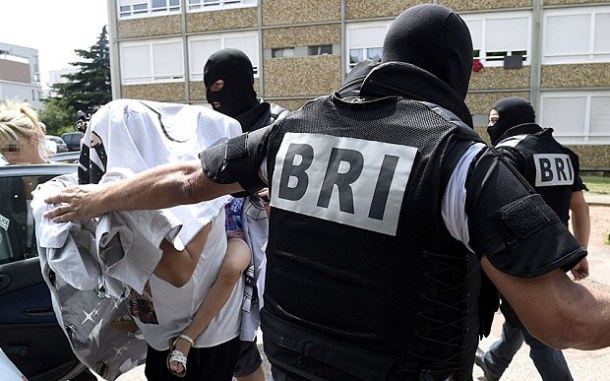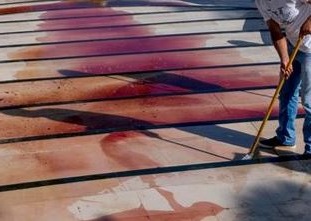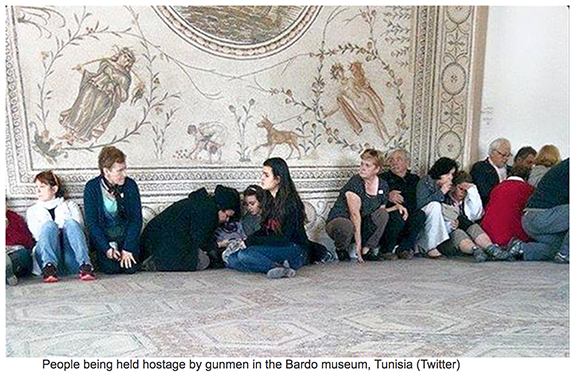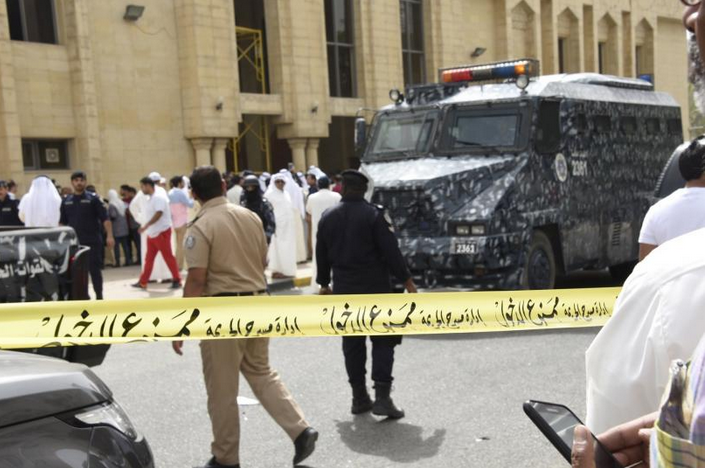Shawn Helton
21st Century Wire
The triple terror attacks seen in France, Tunisia and Kuwait appear to mark another set of tragic events. However, when you peel back the media hysteria, all three of the alleged ISIS related incidents raise a number of interesting questions..

‘The Mask of Security’ – The Research and Intervention Brigades, (BRI) seizing a suspect after an apparent attack on a French factory near Lyon in southeastern France. (Photo link baodongnai.com)
The French Connection
The French BRI, who are are an elite law enforcement unit of the French Ministry of the Interior, have been known to monitor suspects prior to a crime taking place. This echoes a similar investigative tactic in the US, as the FBI has often been linked to a person or persons before an alleged attack through lengthy surveillance protocols.
A primary example of this was the series of events that unfolded in Garland, Texas recently.
Back in May, the anti-Islamic media personality Pamela Geller, who is the president of the well-funded organizations, the American Freedom Defense Initiative, and Stop the Islamization of America, organized a “Prophet Mohammed Drawing Contest” in Garland, Texas. The event allegedly became a target of two ‘ISIS inspired’ shooters. However, it was quickly revealed that the FBI had known at least one of the apparent shooters well before the seemingly orchestrated attack.
As we previously outlined here at 21WIRE, Elton Simpson, one of perpetrators listed in the Garland fiasco, had been under the watchful eye of the FBI for nearly a decade and was in close contact with an undercover informant during that time.
Fast forward to the recent attack in France…
French Prosecutor Francois Molins, said that security services were well aware of the suspect charged in an apparent beheading and gas canister explosion at the American owned Air Products factory in France. An early report from CNN, exposed the ties between the French security services and the alleged suspect, Yassin Salhi, as the Mayor of a town close by had easily been able identify the suspect charged in the apparent attack:
“Raymond Feyssaguet, the mayor of the nearby town of Villefontaine, identified the suspect as Yassin Salhi.
The suspect has three children and has been married for 10 years, Molins said. He does not have a police record, but in 2006 he was put on the terrorist watch list and “he continued to attract the attention of the intelligence services, particularly with regard to the Lyon region.”
In a strange twist, Salhi denied any jihadist motivation for the crime according to a Reuters release:
“The man being held in France under suspicion of beheading his boss and trying to blow up a chemicals plant has told investigators there was no religious motivation behind the attack.”
What really happened in France and why was Salhi known to security services for nearly a decade?
Whether it’s the BRI, FBI or any other alphabet agency, a clear pattern has emerged, one linking intelligence services to suspected criminals before an alleged attack has been carried out.

‘Hotel Hell’ – The Imperial Marhaba hotel staff are seen cleaning up blood without any protective gear. Note that the rest of the grounds appear to be untouched. (Photo link theguardian.com)
Tension Rises in Tunis
As 21 WIRE has noted a number of times, many so-called ‘terror events’ involve individuals being monitored by security services prior to an alleged act taking place. In fact, very often those being watched by authorities, depict all the tell-tale signs of a patsy or an informant, working either with law enforcement or some intelligence agency. Historically, government operators have often made use of low-life criminals, and mentally disturbed individuals.
Back in late March, the apparent attack on the Bardo Museum in Tunisia was also not without some ‘questionable’, albeit, all too familiar activity taking place prior to the museum shooting.
An important fact to remember, is that the shooting at the Bardo Museum happened while the Tunisian Parliament was in session proposing “new terror measures.”

‘Twitter Terror’ – Here we have an image of the hostages said to be held during the Bardo Museum attack. (Photo link telegraph.co.uk)
Tunisian security services ‘knew’ at least one terrorist suspect and claim he was under some level of surveillance prior to the attack (like the Paris shootings and some many others), as mentioned by global media outlets, including this excerpt from a CNN report at the time:
“Earlier Thursday, Tunisian Prime Minister Habib Essid identified two suspects, Yassine Labidi and Saber Khachnaou, in an interview with French radio station RTL. It’s not clear if those two men were the pair killed at the museum by Tunisian security forces, or if it’s possible they’re the same people as those identified — using new names — in ISIS’ audio statement.
Labidi was “known to the security services, he was flagged and monitored,” Essid said. But he added the man wasn’t known or being followed for anything special.”
There have been many terror attacks propagandized by mass media and authorities – only to have the incident connected in some way to security operations.
Is this what happened at the Imperial Marhaba Hotel or was it something else?

‘Posing with Guns’ – Suspected Tunisian resort shooter Seifeddine Rezgui, along with the familiar SITE logo. (Photo link twitter.com)
Sousse Resort Shooting
A single gunman, 24 year-old Seifeddine Rezgui (Saif Rezgui) was named in the Sousse beach resort attack this past Friday. He is said to have opened fire on tourists at the beach before entering the luxury hotel. All told, the suspected gunman Rezgui, apparently killed 39 people before being shot by police.
In a news release from Reuters, we learn that Rezgui met with family and friends in the days leading up to the resort attack without displaying an unusual signs:
“On Wednesday, Saif Rezgui sat down with friends in his Tunisian hometown to chat about his favourite football team, girls and his breakdance skills over coffee and cigarettes.
On Thursday, he met up with his uncle in Gaafour, catching up on family matters, on a break from his master’s studies in the nearby historic town of Kairouan.”
Authorities now state that at least 18 of the victims were British, with other victims being listed from Tunisia, Germany, Belgium, France and Russia, as death tolls are said to rise.
The Daily News reports:
“Rezgui was a good student from a stable family who enjoyed partying and break-dancing, according to officials. He was a Tunisian native who became radicalized without ever leaving his homeland. Rezgui was from a small village in northwestern Tunisia and had never traveled abroad.”
Continuing the report underscores the lack of credible information linking Rezgui to any terror group:
“He was a good student and always attending class,” said Prime Minister Habib Essid at a Saturday news conference. “Our investigations show he didn’t reveal any signs of extremism, or ties to terrorists. He wasn’t even on a watch list.”
Sky News has released a video from one of the hotel guests, only adding to the mystery of what happened at the Tunisian resort.
While Rezgui is said to have no direct connection to terror, Tunisia’s resorts were targeted nearly 30 years ago, as Germany’s Spiegel reports.
The UK’s Mirror reported that “Sniper marksmen scaled the roofs of nearby hotels after Abu Yahya Qayrawani (Saif Rezgui) murdered scores of holidaymakers on the popular holiday resort.”
Curiously before the attack, authorities acknowledge that new ‘heightened security measures‘ were put in place for the summer, as Tunisia was already working on new ant-terror measures back in March, during the Bardo Museum attack.

‘Broadcasting Fear’ – We’re told the image above is the suspected resort gunman calmly walking on the beach among onlookers. (Photo link twitter.com)
We need to also consider eyewitness testimony at the crime scene, as initial reports state that a second shooter was apprehended according to the news outlet Tunisia-live. Additionally, an eyewitness report claims that a “group of terrorists” came ashore by boat, firing while still at sea. Confusingly, another witness observed the following at the scene :
“They shot the first line of people on the beach and then turned the boat and left.”
Accounts seems to differ from the official narrative, as only Rezgui was named in the attack by authorities – who were the other individuals that eyewitnesses claim that they saw?
In a Guardian news release we learn more about the apparent attack:
“A tweet from the Islamic State group claimed responsibility for the attack and gave his jihadi pseudonym of Abu Yahya al-Qayrawani, which referred to the town, an ancient centre of Islamic learning, where he was studying for his degree, according to the Site intelligence group. He had taken out a Tunisian passport in 2013, but had never used it, an official said.”
As the Guardian report continues, we see that not everyone close to Rezgui believes he was completely responsible for the attack:
“He was good, good, good!” said a neighbour and family friend, Monia Riahi, 50, standing with her daughters at the entrance to her house. “I’ve known him since he was small. He was never in trouble with anyone ever. Maybe he was brainwashed or something.”
“The country’s tourist economy had taken a major blow in the aftermath of the 2011 “Jasmine” revolution but with new elections in late 2014, was returning to stability.”
Although we’ve been told that ISIS has claimed responsibility for the attack, SITE Intelligence Group ‘confirmed’ the attack claims via social media.
As we’ve discussed many times here at 21WIRE, the intelligence monitoring group SITE, has ties to both the CIA and Israeli intelligence. Over the years ethical concerns about the group have been raised and according to the group’s founder, Rita Katz – they’ve managed to release terror related material linked to ISIS prior to the militant group itself.
The attack at the Tunisia resort is similar to a seemingly staged ‘double attack’ said to have taken place outside the Corinthia hotel in Tripoli in early January. According to SITE, an ISIS linked terror group called ‘Tripoli Province‘ had claimed credit for the attacks at the luxury hotel.
It’s important to consider that Tunisia has also been in trade talk negotiations with the European Union, as new talks are set for October.

‘Kuwait Mosque Attack’ – The scene at Imam Sadiq Mosque in Kuwait City after a suicide bomber killed 25 Shiite worshippers. (Photo link rpp.com.pe)
The attack in Kuwait underlines the growing problem of ISIS, manufactured or not. The recent attack at the Kuwaiti mosque is just more evidence of a cascading nightmare throughout the Middle East. The public will most likely see a ramp up of this kind of violence as the West is looking for a larger coalition to invade Iraq and Syria.
When Security Breeds Terror
In an article published at Global Research written by Andrew Gavin Marshall, entitled “State-Sponsored Terror: British and American Black Ops in Iraq,” we see the historical outline and correlation between security agencies and the terror that’s never too far behind:
In January of 2002, the Washington Post ran a story detailing a CIA plan put forward to President Bush shortly after 9/11 by CIA Director George Tenet titled, “Worldwide Attack Matrix,” which was “outlining a clandestine anti-terror campaign in 80 countries around the world. What he was ready to propose represented a striking and risky departure for U.S. policy and would give the CIA the broadest and most lethal authority in its history.”
As the article continues, we see the growing power of clandestine intelligence agencies and their direct involvement in so-called ‘terrorist’ incidents, most notably with the CIA since 9/11: “the creation of a super-Intelligence Support Activity, an organization it dubs the Proactive, Preemptive Operations Group (P2OG), to bring together CIA and military covert action, information warfare, intelligence and cover and deception.
The Global Research treasure trove also includes a Telegraph news release from February 5, 2007: “Deep inside the heart of the “Green Zone” [in Iraq], the heavily fortified administrative compound in Baghdad, lies one of the most carefully guarded secrets of the war in Iraq. It is a cell from a small and anonymous British Army unit that goes by the deliberately meaningless name of the Joint Support Group (JSG).”
It turns out that the JSG, also operated under the cover moniker, Force Research Unit (FRU) “which between the early 1980s and the late 1990s managed to penetrate the very heart of the IRA.” The FRU turned and blackmailed members of the IRA to work for the paramilitary organization as double agents. All told, the FRU/JSG was able to establish control at the highest levels of the IRA. The unit was renamed in the aftermath of Stevens Inquiry, which investigated allegations of a collusion between the security forces and protestant paramilitary groups:
“The Stevens Inquiry’s report “contains devastating confirmation that intelligence officers of the British police and the military actively helped Protestant guerillas to identify and kill Catholic activists in Northern Ireland during the 1980s.”
Former British intelligence agent, Kevin Fulton, who also worked with the FRU, stated that knowledge of the orchestrated unit was known by high level officials, claiming they had been ‘sanctioned’ by former PM Margaret Thatcher.
According to a former British Army mole, the MI5 organized a “weapons-buying trip to America in which he obtained detonators, later used by terrorists to murder soldiers and police officers.”
“The technology he obtained has been used in Northern Ireland and copied by terrorists in Iraq in roadside bombs that have killed British troops.”
When examining the shocking claims of CIA operations, along with stories of British intelligence operatives colluding with the IRA in deep cover terrorist acts in Northern Ireland via the FRU, your reminded of the heavily orchestrated attacks within Iraq, that continue to stoke the flames in the Sunni–Shia civil war.
The timing and nature of what happened in France, Tunisia and Kuwait should also be considered, as it’s no coincidence that the attacks occurred as we near the 10 year anniversary of London’s 7/7 bombing.
More than 60 are said to have died in the events that unfolded in all three locations last week.
What will come next in the global theater play of security and terror?
Below is an analysis of this wider issue from 21WIRE editor Patrick Henningsen on RT News…
.
UPDATE: There have now been several other men arrested in connection with the Sousse resort attack.
READ MORE ISIS NEWS AT: 21st Century Wire ISIS Files
SUPPORT 21WIRE – SUBSCRIBE & BECOME A MEMBER @21WIRE.TV















